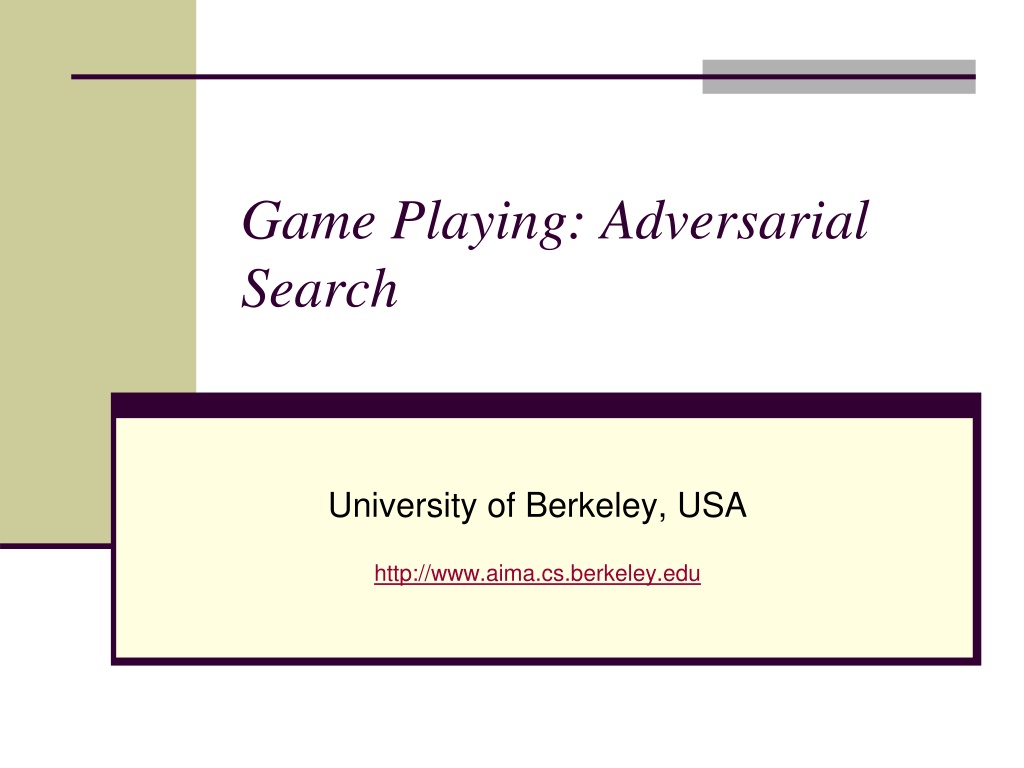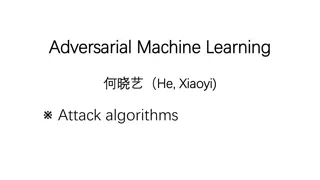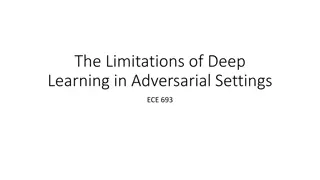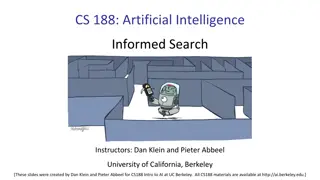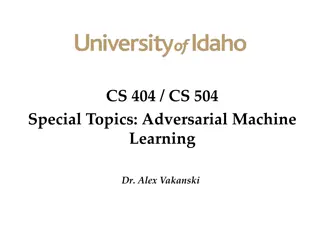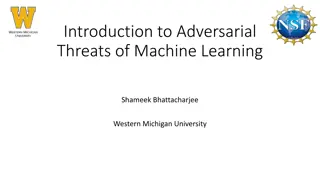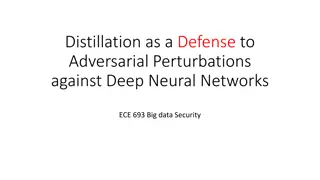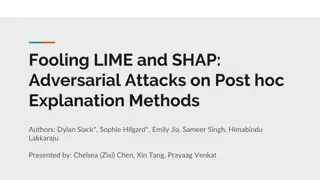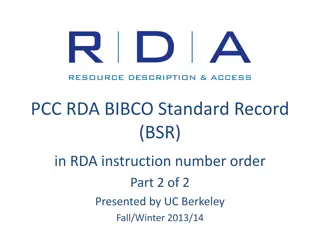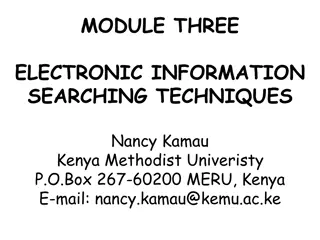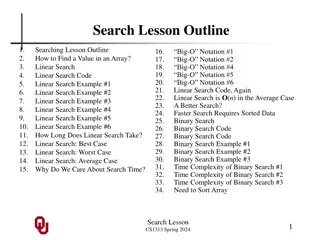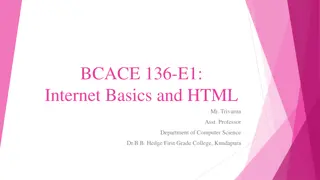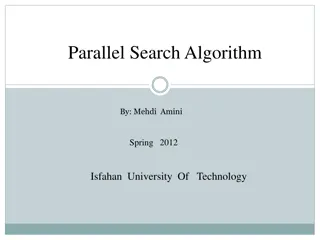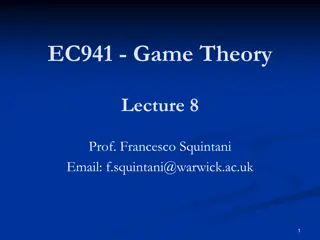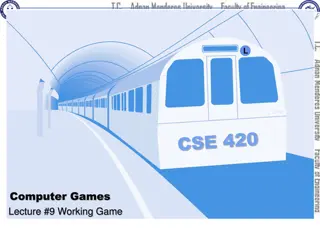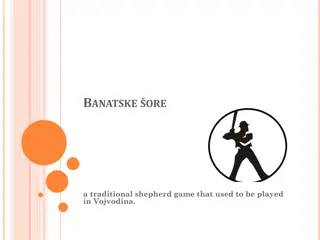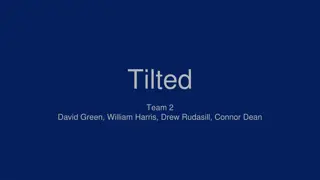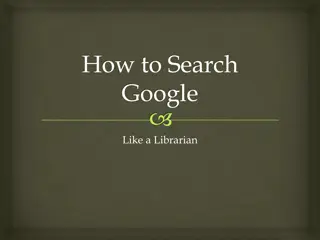Understanding Game Playing and Adversarial Search at University of Berkeley
Delve into the realm of game playing and adversarial search at the University of Berkeley to understand the complexities of multi-agent environments. Explore the concepts of competitive MA environments, different kinds of games, and the strategic decision-making processes involved in two-player games. Discover how game playing serves as a fascinating intersection of human and computational intelligence, offering insights into deterministic, perfect information, and imperfect information games.
- Game Playing
- Adversarial Search
- University of Berkeley
- Multi-Agent Environments
- Strategic Decision-Making
Download Presentation

Please find below an Image/Link to download the presentation.
The content on the website is provided AS IS for your information and personal use only. It may not be sold, licensed, or shared on other websites without obtaining consent from the author. Download presentation by click this link. If you encounter any issues during the download, it is possible that the publisher has removed the file from their server.
E N D
Presentation Transcript
Game Playing: Adversarial Search University of Berkeley, USA http://www.aima.cs.berkeley.edu
Outline - Game Playing: Adversarial Search - Minimax Algorithm - - Pruning Algorithm - Games of chance - State of the art
Game Playing: Adversarial Search Introduction So far, in problem solving, single agent search The machine is exploring the search space by itself. No opponents or collaborators. Games require generally multiagent (MA) environments: Any given agent need to consider the actions of the other agent and to know how do they affect its success? Distinction should be made competitive MA environments. Competitive environments: give rise to adversarial search: playing a game with an opponent. cooperative between and
Game Playing: Adversarial Search Introduction Why study games? Game playing is fun and is also an interesting meeting point for human and computational intelligence. They are hard. Easy to represent. Agents are restricted to small number of actions. Interesting question: Does winning a game absolutely require human intelligence?
Game Playing: Adversarial Search Introduction Different kinds of games: Deterministic Chance Perfect Information Chess, Checkers Go, Othello Backgammon, Monopoly Imperfect Information Battleship Bridge, Poker, Scrabble, Games with perfect information. No randomness is involved. Games with imperfect information. Random factors are part of the game.
Searching in a two player game Traditional (single agent) search methods only consider how close the agent is to the goal state (e.g. best first search). In two player games, decisions of both agents have to be taken into account: a decision made by one agent will affect the resulting search space that the other agent would need to explore. Question: Do we have randomness here since the decision made by the opponent is NOT known in advance? No. Not if all the moves or choices that the opponent can make are finite and can be known in advance.
Searching in a two player game To formalize a two player game as a search problem an agent can be called MAX and the opponent can be called MIN. Problem Formulation: Initial state: board configurations and the player to move. Successor function: list of pairs (move, state) specifying legal moves and their resulting states. (moves + initial state = game tree) A terminal test: decide if the game has finished. A utility function: produces a numerical value for (only) the terminal states. Example: In chess, outcome = win/loss/draw, with values +1, -1, 0 respectively. Players need search tree to determine next move.
Partial game tree for Tic-Tac-Toe Each level of search nodes in the tree corresponds to all possible board configurations for a particular player MAX or MIN. Utility values found at the end can be returned back to their parent nodes. Idea: MAX chooses the board with the max utility value, MIN the minimum.
MinMax search on Tic-Tac-Toe Evaluation function Eval(n) for A infinity if n is a win state for A (Max) -infinity if n is a win state for B (Min) (# of 3-moves for A) -- (# of 3-moves for B) a 3-move is an open row, column, diagonal A is X Eval(s) = 6 - 4 9
Searching in a two player game The search space in game playing is potentially very huge: Need for optimal strategies. The goal is to find the sequence of moves that will lead to the winning for MAX. How to find the best trategy for MAX assuming that MIN is an infaillible opponent. Given a game tree, the optimal strategy can be determined by the MINIMAX- VALUE for each node. It returns: 1. 2. Utility value of n if n is the terminal state. Maximum of the utility values of all the successor nodes s of n : n is a MAX s current node. Minimum of the utility values of the successor node s of n : n is a MIN s current node. 3.
Minimax Algorithm Minimax algorithm Perfect for deterministic, 2-player game One opponent tries to maximize score (Max) One opponent tries to minimize score (Min) Goal: move to position of highest minimax value Identify best achievable payoff against best play
Minimax Algorithm (contd) Max node Min node MAX node MIN node value computed by minimax Utility value
Minimax Algorithm (contd) 3 9 0 7 2 6
Minimax Algorithm (contd) 3 0 2 3 9 0 7 2 6
Minimax Algorithm (contd) 3 3 0 2 3 9 0 7 2 6
Minimax Algorithm (contd) Properties of minimax algorithm: Complete? Yes (if tree is finite) Optimal? Yes (against an optimal opponent) Time complexity? O(bm) Space complexity? O(bm) (depth-first exploration) Note: For chess, b = 35, m = 100 for a reasonable game. Solution is completely infeasible Actually only 1040board positions, not 35100
Minimax Algorithm (contd) Limitations Not always feasible to traverse entire tree Time limitations Improvements Depth-first search improves speed Use evaluation function instead of utility Evaluation function provides estimate of utility at given position
Problem of Minimax search Number of games states is exponential to the number of moves. Solution: Do not examine every node ==> Alpha-beta pruning Alpha = value of best choice found so far at any choice point along the MAX path. Beta = value of best choice found so far at any choice point along the MIN path.
Alpha-beta Game Playing Basic idea: If you have an idea that is surely bad, don't take the time to see how truly awful it is. -- Pat Winston Some branches will never be played by rational players since they include sub-optimal decisions (for either player). >=2 We don t need to compute the value at this node. =2 <=1 No matter what it is, it can t effect the value of the root node. 2 7 1 ?
- Pruning Algorithm Principle If a move is determined worse than another move already examined, then further examination deemed pointless
Alpha-Beta Pruning ( prune) Rules of Thumb is the highest max found so far is the lowest min value found so far If Min is on top Alpha prune If Max is on top Beta prune You will only have alpha prune s at Min level You will only have beta prunes at Max level
Properties of - Prune Pruning does not affect final result Good move ordering improves effectiveness of pruning With "perfect ordering," time complexity = O(bm/2) doubles depth of search
General description of - pruning algorithm Traverse the search tree in depth-first order At each Max node n, alpha(n) = maximum value found so far Start with - infinity and only increase. Increases if a child of n returns a value greater than the current alpha. Serve as a tentative lower bound of the final pay-off. At each Min node n, beta(n) = minimum value found so far Start with infinity and only decrease. Decreases if a child of n returns a value less than the current beta. Serve as a tentative upper bound of the final pay-off. beta(n) for MAX node n: smallest beta value of its MIN ancestors. alpha(n) for MIN node n: greatest alpha value of its MAX ancestors
General description of - pruning algorithm Carry alpha and beta values down during search alpha can be changed only at MAX nodes beta can be changed only at MIN nodes Pruning occurs whenever alpha >= beta alpha cutoff: Given a Max node n, cutoff the search below n (i.e., don't generate any more of n's children) if alpha(n) >= beta(n) (alpha increases and passes beta from below) beta cutoff: Given a Min node n, cutoff the search below n (i.e., don't generate any more of n's children) if beta(n) <= alpha(n) (beta decreases and passes alpha from above)
- Pruning Algorithm function ALPHA-BETA-SEARCH(state) returns an action inputs: state, current state in game v MAX-VALUE(state, - , + ) return the action in SUCCESSORS(state) with value v function MAX-value (n, alpha, beta) return utility value if n is a leaf node then return f(n); for each child n of n do alpha :=max{alpha, MIN-value(n , alpha, beta)}; if alpha >= beta then return beta /* pruning */ end{do} return alpha function MIN-value (n, alpha, beta) return utility value if n is a leaf node then return f(n); for each child n of n do beta :=min{beta, MAX-value(n , alpha, beta)}; if beta <= alpha then return alpha /* pruning */ end{do} return beta
Game Playing: Adversarial Search In another way
Evaluating Alpha-Beta algorithm Alpha-Beta is guaranteed to compute the same value for the root node as computed by Minimax. Worst case: NO pruning, examining O(bd) leaf nodes, where each node has b children and a d-ply search is performed Best case: examine only O(bd/2) leaf nodes. You can search twice as deep as Minimax! Or the branch factor is b1/2rather than b. Best case is when each player's best move is the leftmost alternative, i.e. at MAX nodes the child with the largest value generated first, and at MIN nodes the child with the smallest value generated first. In Deep Blue, they found empirically that Alpha-Beta pruning meant that the average branching factor at each node was about 6 instead of about 35- 40
Evaluation Function Evaluation function Performed at search cutoff point Must have same terminal/goal states as utility function Tradeoff between accuracy and time reasonable complexity Accurate Performance of game-playing system dependent on accuracy/goodness of evaluation Evaluation of nonterminal states strongly correlated with actual chances of winning
Evaluation functions For chess, typically linear weighted sum of features Eval(s) = w1f1(s) + w2f2(s) + + wnfn(s) e.g., w1= 9 with f1(s) = (number of white queens) (number of black queens), etc. Key challenge find a good evaluation function: Isolated pawns are bad. How well protected is your king? How much maneuverability to you have? Do you control the center of the board? Strategies change as the game proceeds
When Chance is involved: Backgammon Board 0 1 2 3 4 5 6 7 8 9 10 11 12 25 24 23 22 20 19 18 17 16 15 14 13 21
Expectiminimax Generalization of minimax for games with chance nodes Examples: Backgammon, bridge Calculates expected value where probability is taken over all possible dice rolls/chance events - Max and Min nodes determined as before - Chance nodes evaluated as weighted average
Expectiminimax Expectiminimax(n) = Utility(n) for n, a terminal state expectiminimax( ) s expectiminimax( ) s max min for n, a Max node s Succ(n) for n, a Min node s Succ(n) for n, a chance node s Succ nP s s ( ) ( )*expectiminimax( )
Game Tree for Backgammon MAX DICE 1/18 1,2 1/36 1,1 6,5 6,6 MIN DICE C 1/18 1,2 1/36 1,1 6,5 6,6 MAX TERMINAL
